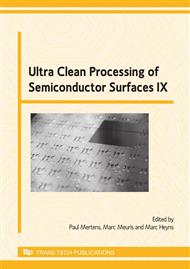p.3
p.7
p.11
p.15
p.19
p.23
p.27
p.31
Impact of Megasonic Activation with Different Chemistries on Silicon Surface in Single Wafer Tool
Abstract:
More and more, 300mm manufacturing promotes a single wafer tool approach in FEOL cleaning. Previously, we reported an advanced surface preparation process based on dilute HF/HCl/DIW and O3/HCl/DIW chemistries coupled with megasonic activation during the ozone step only, on a 300mm single-wafer platform [1]. As throughput consideration implies shorter process time, the activation of megasons during the whole cleaning step could be of interest for very small particle removal efficiency. Nevertheless, extending megasonic activation to the entire process sequence leads to degraded results on silicon surface. Indeed, damages are created at 90 and 65nm defect inspection levels when megasonic activation is used in the presence of both HF species and on hydrophobic silicon surface. In this paper, we demonstrate that the megasonic activation (Megs) generates randomly and locally oxidized species which may be the main cause of damages in the presence of HF chemistry. Additional characterizations are performed to understand this problem (haze inspections, ATR analysis and contact angle measurements).
Info:
Periodical:
Pages:
15-18
Citation:
Online since:
January 2009
Keywords:
Price:
Сopyright:
© 2009 Trans Tech Publications Ltd. All Rights Reserved
Share:
Citation:


